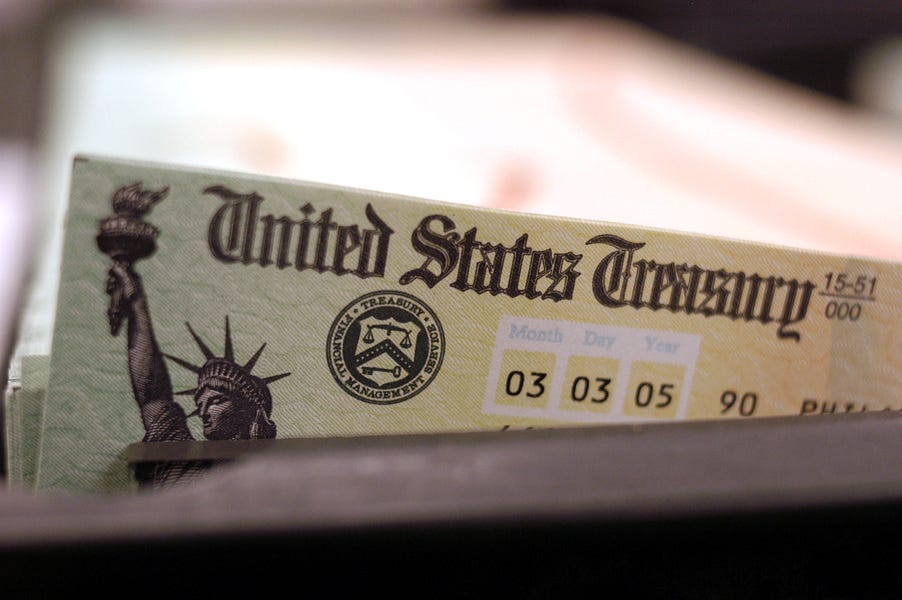Welcome to the world of permanent $1 trillion (or more) budget deficits. The Congressional Budget Office released new budget projections last week, and as troubling as they sound, that’s a rosy scenario that assumes peace, prosperity, and low interest rates. CBO projects that the budget deficit will surge toward $2 trillion by the end of the decade, but that could push to $3 trillion with a return to 1990s interest rates.
Economists have long warned that the federal budget would eventually sink under the weight of surging Social Security and Medicare costs. Taxpayers have heard these warnings for so long that many understandably began tuning them out. A decade ago, the Great Recession brought a $1.4 trillion deficit, most of which gradually evaporated as the economy recovered. That cyclical budget deficit gave many Americans a false sense of security that large budget deficits no longer matter, or at least will go away on their own.
That is no longer the case. The new $1 trillion deficits are occurring in a full-employment economy, and are driven by Social Security and Medicare costs that will continue to accelerate. There is no easy off-ramp, and low interest rates cannot be taken for granted. And even then, a government’s debt cannot rise as a share of its economy indefinitely. At a certain point, perhaps when the next recession grows the debt even faster, the bond market may determine that soaring U.S. debt is no longer a safe investment. The resulting sell-off could trigger a financial panic.
How did we get here? Costs are accelerating because America is now in the middle of 74 million baby boomer retirements occurring between 2008 and 2030. Someone who retires at age 66 and lives until 90 will spend one-third of his adult life in taxpayer-funded retirement. While demographics drive Social Security’s expanding budget, Medicare faces the additional challenge of rising health care costs.
Public understanding of Social Security and Medicare finances is muddled. Too often, the conversation gets bogged down in esoteric discussions of trust fund exhaustion dates, unfunded liabilities, net present values, and whether $3 trillion in Social Security IOUs sitting in a West Virginia filing cabinet represent real economic resources.
Let’s bypass all the jargon and examine the CBO budget projections.
Between 2019 and 2049, the Social Security system will collect $56 trillion in payroll taxes and benefit taxes, and spend $75 trillion in benefits. That resulting $19 trillion cash shortfall must be financed with general revenues. Over that same period, the Medicare system will collect $17 trillion in payroll taxes and dedicated revenues, and spend $61 trillion in benefits, producing a $44 trillion cash shortfall.
The federal borrowing that is scheduled to finance much of these shortfalls will add $40 trillion in interest payments on the national debt.
Add it all up, and Social Security and Medicare face a $103 trillion cash shortfall over the next 30 years, including those resulting interest costs. The rest of the federal budget will run a $23 trillion surplus. Washington does not have a general budget deficit problem; it has a Social Security and Medicare problem. Even if the Social Security Trust Fund contained real economic assets from which to pay benefits—and it does not—it would close less than 3 percent of this gap.
Those who dismiss 30-year budget projections should note that the existence of 74 million baby boomers is not a theoretical guess like an inflation rate. The boomers walk among us, and their Social Security and Medicare payment formulas are already set in permanent law. The typical married couple retiring today will, over their lifetime, have paid $161,000 into the Medicare system, and receive $498,000 in benefits. They will also come out $70,000 ahead in Social Security. Now multiply these shortfalls by 74 million retiring baby boomers and factor in a shortage of working-age taxpayers to replenish the revenues. The math is unforgiving.
These costs are growing over time. The yearly Social Security and Medicare shortfall was $440 billion last year. It is projected to reach $1.869 trillion in 2030. This $1.4 trillion cost increase explains virtually the entire growth in the projected budget deficit over the next decade.
The media instead focuses on the 2017 tax cuts as driving the long-term deficit. This is due to both ideological hostility to the tax cuts (the equally large increases in discretionary spending enacted shortly thereafter received only a small fraction of the criticism), and the fact that Social Security and Medicare cost increases occur automatically each year, by formula, without any congressional votes or presidential signing ceremony to cover.
More reporters should focus on the real deficit drivers. The 2017 tax cuts cost approximately $250 billion annually, including interest (and are scheduled to expire within a decade). The defense budget is projected to rise by roughly $250 billion over the decade as well. These costs will be dwarfed by Social Security and Medicare shortfalls that rise by $1.4 trillion through 2030.
Should we care about red ink? Critics point out that the economy is growing, wages are rising, and interest rates are low. Yet an economy’s ability to handle a $900 billion deficit during an economic boom does not guarantee that it can easily absorb the coming $2 trillion deficits (and higher), especially when the boom ends.
Nevertheless, noted economists such as Olivier Blanchard, Jason Furman, and Lawrence Summers assert that low interest rates make the national debt relatively affordable. In reality, even low interest rates won’t help much when the underlying debt is growing steeply.
The CBO assumes the interest rate on the national debt never rises above 4.2 percent again—a rate far below the average of the 1980s through 2000s. And yet the rising debt principal would still push the interest costs of the debt from 1.2 percent of the economy to as high as 7.6 percent between 2015 and 2049, assuming the extension of current policies.
By that point, interest costs would be Washington’s largest annual expenditure, consuming 42 percent of all projected tax revenues. The 7.6 percent of the economy spent on government debt interest would exceed spending on Social Security (6.2 percent), Medicare (6.0 percent), and defense (2.6 percent).
That is the rosy scenario of low interest rates. If rates do rise, each one percentage point would cost Washington $1.8 trillion over the decade, and $11 trillion over 30 years (raising the debt by 17 percent of GDP).. By that math, a mere two percentage-point interest rate rise would cost more than the entire Social Security shortfall.
Deficit doves would gamble America’s fiscal future on the hope that interest rates remain at historic lows forever—and ignore that even low interest rates will not save us from an underlying debt growing so quickly. It is like a middle-class family taking out an unaffordable $2 million mortgage, at an adjustable interest rate, simply because today’s rates are low.
An American debt crisis is especially dangerous because no other economy has the capacity to bail America out. When Greece ran its debt up to 180 percent of its economy, the $350 billion debt level was easy for the global economy to rescue. When America’s debt approaches 200 percent of its much larger economy—a likely occurrence if current policies continue—other nations will not have $100 trillion available to bail us out.
Reform will not be easy. A $103 trillion shortfall cannot be closed simply by lifting the wage cap on Social Security taxes, cutting defense and welfare, or taxing the rich. Not even close. Significant Social Security and Medicare reforms are required, and taxes will not be spared. Washington can gradually phase-in these reforms while the economy is still strong and many near-retirees have time to adjust to any new policies. Or, it can wait until all 74 million baby boomers have already retired, benefits have been locked in, and deepening red ink (and possibly a recession) force more drastic reforms.
Republicans will not discuss the deficit because it puts them on the defensive over the 2017 tax cuts. And Democratic presidential candidates are pouring gasoline on the fire by promising as much as $97 trillion in additional spending over the decade. It is a conspiracy of silence that will ultimately cost taxpayers and retirees dearly.
Brian Riedl is a senior fellow at the Manhattan Institute. Follow him on twitter @Brian_Riedl.
Photograph of Social Security checks being printed by William Thomas Cain/Getty Images.







Please note that we at The Dispatch hold ourselves, our work, and our commenters to a higher standard than other places on the internet. We welcome comments that foster genuine debate or discussion—including comments critical of us or our work—but responses that include ad hominem attacks on fellow Dispatch members or are intended to stoke fear and anger may be moderated.
With your membership, you only have the ability to comment on The Morning Dispatch articles. Consider upgrading to join the conversation everywhere.